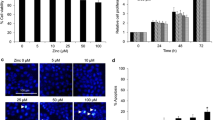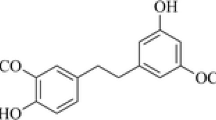Abstract
Cancer cell aggregation has been long known to facilitate metastatic potential of cancer cells. In addition, the presence of nitric oxide (NO) in cancer area may have a significant impact on aggregation behavior of the cells. We show herein that lung cancer H460 cells possessing high ability of anoikis resistance formed loose aggregates in detached condition. Importantly, NO treatment tightened the aggregates by enhancing cell–cell interaction via E-cadherin-dependent mechanism, and such E-cadherin contact increased anoikis resistance potential by up-regulating pro-survival signals of the cells including active ATP-dependent tyrosine kinase and extracellular-regulated protein kinases (ERK1/2). Since an increase of E-cadherin was frequently found in mesenchymal to epithelial transition (MET) process, we further tested the cells for MET markers and found that NO treatment of these cells significantly enhanced MET. As aggregation and MET of cancer cells may facilitate cancer metastasis by many means, the insights gained from the present study could benefit the deep understanding in the biology of cancer cell metastasis.





Similar content being viewed by others
Abbreviations
- AKT:
-
ATP-dependent tyrosine kinase
- Cav-1:
-
Caveolin-1
- NO:
-
Nitric oxide
- XTT:
-
2,3-Bis-(2-methoxy-4-nitro-5-sulfophenyl)-2H-tetrazolium-5-carboxanilide salt
- E-cad:
-
E-cadherin
- N-cad:
-
N-cadherin
- Vim:
-
Vimentin
- p-AKT:
-
Phosphorylated AKT
- PBS:
-
Phosphate-buffered saline
- Mcl-1:
-
Myeloid cell leukemia sequence 1
- TBST:
-
Tris-buffered saline with 0.1 % Tween
- PI:
-
Propidium iodide
References
Glinsky VV, Glinsky GV, Glinskii OV, Huxley VH, Turk JR, Mossine VV, Deutscher SL, Pienta KJ, Quinn TP (2003) Intravascular metastatic cancer cell homotypic aggregation at the sites of primary attachment to the endothelium 1. Cancer Res 63:3805–3811
Saiki I, Naito S, Yoneda J, Azuma I, Price JE, Fidler IJ (1991) Characterization of the invasive and metastatic phenotype in human renal cell carcinoma. Clin Exp Metastasis 9:551–566
Glinsky GV, Glinsky VV (1996) Apoptosis and metastasis: a superior resistance of metastatic cancer cells to programmed cell death. Cancer Lett 101:43–51
Topal B, Roskams T, Fevery J, Penninckx FJ (2003) Aggregated colon cancer cells have a higher metastatic efficiency in the liver compared with nonaggregated cells: an experimental study. Surg Res 112:31–37
Fidler IJ (1975) The relationship of embolic homogeneity, number, size and viability to the incidence of experimental metastasis. Eur J Cancer 9:223–227
Guadamillas MC, Cerezo A, Del Pozo MA (2011) Overcoming anoikis–pathways to anchorage-independent growth in cancer. J Cell Sci 124(Pt 19):3189–3197. doi:10.1242/jcs.072165
Simpson CD, Anyiwe K, Schimmer AD (2008) Anoikis resistance and tumor metastasis. Cancer Lett 272:177–185. doi:10.1016/j.canlet.2008.05.029
Chunhacha P, Pongrakhananon V, Rojanasakul Y, Chanvorachote P (2012) Caveolin-1 regulates Mcl-1 stability and anoikis in lung carcinoma cells. Am J Physiol Cell Physiol 302:1284–1292
Ma XK, Wang L, Li Y, Yang XM, Zhao P, Tang H, Zhu P, Li L, Chen ZN (2010) HAb18G/CD147 cell–cell contacts confer resistance of a HEK293 subpopulation to anoikis in an E-cadherin-dependent manner. BMC Cell Biol 11:27
Shen X, Kramer RH (2004) Adhesion-mediated squamous cell carcinoma survival through ligand-independent activation of epidermal growth factor receptor. Am J Pathol 165:1315–1329
Halim H, Luanpitpong S, Chanvorachote P (2012) Acquisition of anoikis resistance up-regulates caveolin-1 expression in human non-small cell lung cancer cells. Anticancer Res 32:1649–1658
Zhao M, Gao Y, Wang L, Liu S, Han B, Ma L, Ling Y, Mao S, Wang X (2013) Overexpression of integrin-linked kinase promotes lung cancer cell migration and invasion via NF-κB-mediated upregulation of matrix metalloproteinase-9. Int J Med Sci 10:995–1002. doi:10.7150/ijms.5963
Thiery JP (2002) Epithelial–mesenchymal transitions in tumour progression. Nat Rev Cancer 2:442–454
Thiery JP, Acloque H, Huang RY, Nieto MA (2009) Epithelial–mesenchymal transitions in development and disease. Cell 139:871–890
Jia J, Zhang W, Liu JY, Chen G, Liu H, Zhong HY, Liu B, Cai Y, Zhang JL, Zhao YF (2012) Epithelial mesenchymal transition is required for acquisition of anoikis resistance and metastatic potential in adenoid cystic carcinoma. PLoS One 7:e51549. doi:10.1371/journal.pone.0051549
Reddy P, Liu L, Ren C, Lindgren P, Boman K, Shen Y, Lundin E, Ottander U, Rytinki M, Liu K (2005) Formation of E-cadherin-mediated cell–cell adhesion activates AKT and mitogen activated protein kinase via phosphatidylinositol 3 kinase and ligand-independent activation of epidermal growth factor receptor in ovarian cancer cells. Mol Endocrinol 19:2564–2578
Alpaugh ML, Tomlinson JS, Kasraeian S, Barsky SH (2002) Cooperative role of E-cadherin and sialyl-Lewis X/A-deficient MUC1 in the passive dissemination of tumor emboli in inflammatory breast carcinoma. Oncogene 21:3631–3643
Auersperg N, Pan J, Grove BD, Peterson T, Fisher J, Maines-Bandiera S, Somasiri A, Roskelley CD (1999) E-cadherin induces mesenchymal-to-epithelial transition in human ovarian surface epithelium. Proc Natl Acad Sci USA 96:6249–6254
Manda G, Nechifor MT, Neagu T-M (2009) Reactive oxygen species, cancer and anti-cancer therapies. Curr Chem Biol 3:22–46
Keibel A, Vb Singh, Sharma MC (2009) Inflammation, microenvironment, and the immune system in cancer progression. Curr Pharm Des 15:1949–1955
Lala PK, Chakraborty C (2001) Role of nitric oxide in carcinogenesis and tumour progression. Lancet Oncol 3:149–156
Masri FA, Comhair SAA, Koeck T, Xu W, Janocha A, Ghosh S, Dweik RA, Golish J, Kinter M, Stuehr DJ, Erzurum SC, Aulak KS (2005) Abnormalities in nitric oxide and its derivatives in lung cancer. Am J Respir Crit Care Med 172:597–605. doi:10.1164/rccm.200411-1523OC
Esme H, Cemek M, Sezer M, Saglam H, Demir A, Melek H, Unlu M (2008) High levels of oxidative stress in patients with advanced lung cancer. Respirology 13:112–116
Chanvorachote P, Nimmannit U, Lu Y, Talbott S, Jiang BH, Rojanasakul Y (2009) Nitric oxide regulates lung carcinoma cell anoikis through inhibition of ubiquitin-proteasomal degradation of caveolin-1. J Biol Chem 284:28476–28484
Chanvorachote P, Nimmannit U, Stehlik C, Wang L, Jiang BH, Ongpipatanakul B, Rojanasakul Y (2006) Nitric oxide regulates cell sensitivity to cisplatin-induced apoptosis through S-nitrosylation and inhibition of Bcl-2 ubiquitination. Cancer Res 66:6353–6360
Chanvorachote P, Nimmannit U, Wang L, Stehlik C, Lu B, Azad N, Rojanasakul Y (2005) Nitric oxide negatively regulates Fas-induced apoptosis through inhibition of ubiquitin-proteasome-mediated degradation of FLICE inhibitory protein. J Biol Chem 280:42044–42050
Sanuphan A, Chunhacha P, Pongrakhananon V, Chanvorachote P (2013) Long-term nitric oxide exposure enhances lung cancer cell migration. Biomed Res Int 2013:186972. doi: 10.1155/2013/186972
Moncada S, Higgs A (1993) The l-arginine-nitric oxide pathway. N Engl J Med 329:2002–2012
Hanahan D, Weinberg RA (2011) Hallmarks of cancer: the next generation. Cell 144:646–6474. doi:10.1016/j.cell.2011.02.013
Chunhacha P, Sriuranpong V, Chanvorachote P (2013) Epithelial-mesenchymal transition mediates anoikis resistance and enhances invasion in pleural effusion-derived human lung cancer cells. Oncol Lett 5:1043–1047
Acknowledgments
The authors would like to thank the 100th Anniversary Chulalongkorn University Fund for Doctoral Scholarship, Ratchadaphiseksompot Endowment Fund, Chulalongkorn University (RES560530132-HR), and Mr. Krich Rajprasit, proofreader.
Author information
Authors and Affiliations
Corresponding author
Rights and permissions
About this article
Cite this article
Powan, P., Chanvorachote, P. Nitric oxide mediates cell aggregation and mesenchymal to epithelial transition in anoikis-resistant lung cancer cells. Mol Cell Biochem 393, 237–245 (2014). https://doi.org/10.1007/s11010-014-2066-7
Received:
Accepted:
Published:
Issue Date:
DOI: https://doi.org/10.1007/s11010-014-2066-7




